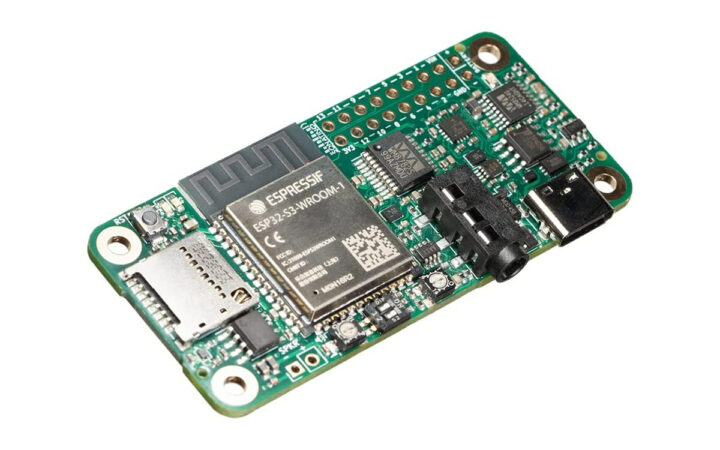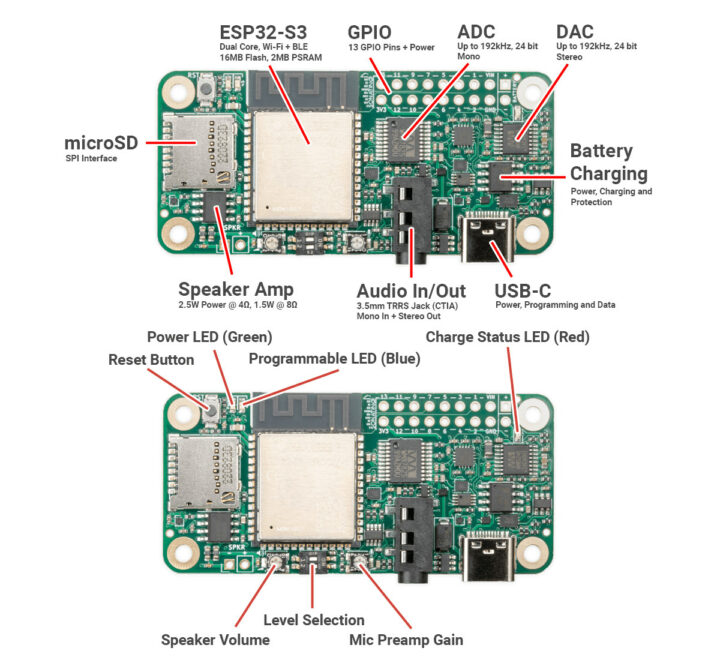Lumination Labs’ Sonatino is an ESP32-S3 board designed for audio applications that follows the Raspberry Pi Zero dimensions so that it can be used with some of the cases designed for the Raspberry Pi Zero.
The wireless audio board features Cirrus Logic WM8524 audio DAC and WM8782 audio DAC capable of 24-bit 192kHz stereo output and mono input respectively, a speaker amplifier and two pins for speaker connection, a 3.5mm audio jack, as well as a microSD card slot for the storage of audio or other data.
Sonatino specifications:
- Wireless Module – ESP32-S3-WROOM-1 with
- SoC – ESP32-S3 dual-core LX7 microprocessor @ up to 240 MHz with Vector extension for machine learning
- Memory – 2MB PSRAM
- Storage – 16MB flash
- Connectivity – WiFi 4 and Bluetooth 5 LE/Mesh
- Storage – MicroSD card slot (SPI)
- Audio
- 3.5mm audio jack supporting input and output (TRRS, CTIA standard)
- Speaker connection: onboard pins, optional screw terminal
- DAC: Cirrus Logic WM8524 up to 24-bit 192kHz output (stereo)
- ADC: Cirrus Logic WM8782 up to 24-bit 192kHz input (mono)
- Audio format: I2S
- Speaker Amp – PAM8302 2.5W @ 4 (mono) with adjustable volume
- Stereo Headphone Amp: TPA6132A2
- Microphone Preamp: MAX4467
- Input Level: Mic or line level
- Output Level: Line or headphone level
- USB – 1x USB Type-C for power, programming, and data
- Expansion – 2x 8-pin headers with 13 GPIOs, Vin, +3.3V, GND
- Misc
- Trim pots for adjusting speaker volume and mic gain
- Dip switches for selecting mic/line level and line/headphone level
- Power, charging, and user LEDs
- Power Supply
- 5V via USB-C port
- 3.7V LiPo/Li-Ion battery via onboard pins or optional JST PH 2 battery connector
- Charging circuit including overcharge and over-discharge protection
- Low-Power Mode – ESP32-S3 supports deep sleep, and audio components can be put into low-power mode to extend battery life
- Dimensions – 65 x 30 x 7mm (Same size as Raspberry Pi Zero)
- Weight – 11 grams
You’ll find two Arduino code samples on GitHub: one playing an MP3 file from the flash or microSD card, and the other performing real-time audio processing with a basic reverb effect. The latter uses Verlib which runs on the CPU and does not involve the vector extension for processing.
The developer is selling the Sonatino board on Amazon for $49.99 but it’s currently out of stock. More boards are coming in the next few weeks. Note it’s basically a personal project, which explains the relatively high price and limited availability as explained on Reddit. We’ve written about several ESP32 audio boards in the past including the official ESP32-LyraTD-MSC from Espressif, ESP32-A1S audio development kit, the PICO DSP board, and others, but I think the Sonatino is the first ESP32-S3 board I’ve seen.
Via Hackster.io

Jean-Luc started CNX Software in 2010 as a part-time endeavor, before quitting his job as a software engineering manager, and starting to write daily news, and reviews full time later in 2011.
Support CNX Software! Donate via cryptocurrencies, become a Patron on Patreon, or purchase goods on Amazon or Aliexpress







This reminds me of Lockpicking Lawyer where he picks modern locks and then calls them out for making careless mistakes that completely defeat the lock security.
Sadly, with the DAC sharing the board power supply directly with the entirety of the rest of the board and its various spurious loads, and with no capacitor set, and not even a zener diode to clip the noise somewhat, this cannot possibly be anything other than $50 e-waste as far as audio quality is concerned. At best you will get equivalent to poor FM radio signal quality out of this.
Calling out 192/24 is purely a snake oil sales tactic. 192kHz/24-bit isn’t meaningfully supported by bluetooth under any circumstance. Even 44.1kHz/16-bit isn’t properly supported unless both source and sink support ALAC or FLAC over bluetooth. None of the other codecs reach 1984 CD quality let alone 24-bit, let alone 192khz at 24-bit.
Seriously, for shame.
I think the mistake is to put ADC/DAC onboard than make a ESP32-S3 Audio shim(s)
The ESP32-S3 has to great multipurpose I2S ports and vector accelerated DSP to make really great audio products.
It can use Wifi or Bluetooth as a link layer and Cirrus Logic WM8524 audio DAC and WM8782 audio DAC capable of 24-bit 192kHz stereo output and mono input is the spec max, correct and not snakeoil.
It might seem a great idea to create an all-in-one with the likes of
But for many applications those might not meet requirements or be surplus to so pigeon holing the board for a very niche market.
As an ADC Shim I would love to see http://www.everest-semi.com/pdf/ES7243%20PB.pdf as its included in the ESP32 ADF as part of its ESP32-S3-Box-Lite technology demonstrator.
Also same with the http://www.everest-semi.com/pdf/ES7210%20PB.pdf its x4 channel TDM mode ADC of the original ESP32-S3-Box.
Both can be used x2 as the I”S ports on the S3 are Bidirectional and could provide some really novel Wifi audio products.
Same with the DACs from those x2 projects as http://www.everest-semi.com/pdf/ES8156%20PB.pdf & http://www.everest-semi.com/pdf/ES8311%20PB.pdf
Would be great as already part of the ADF.
Make Shims and even maybe Shim shims for preamps such as https://www.analog.com/media/en/technical-documentation/data-sheets/max9814.pdf as a stereo version would be great.
Shims are easy to implement and allow solutions to mix and match and don’t have toy like amplifiers of little use such as PAM8302 2.5W …
I keep my fingers crossed that someone my start the ball rolling for ESP32-S3 audio shims that with simple dupont cables we can implement with any ESP32 in a config of our choice.
That hopefully will be cloned and sold in bulk as I have no idea why audio kits constrain to a very specific and singular hardware design for ESP32.
I find it surprising that the DAC and the power amp are diagonally placed on the board with the power input close to the DAC, with the low-level analog signals being routed through all power chips etc. And just like William mentions above, I often find it fun to read about 24-bit when you realize that on 16-bit you’re usually dealing with a few bits of noise anyway (it’s 15 microvolts resolution per volt at 16 bits, and 60 nanovolts at 24 bits). I’d dare anyone to maintain such a level of power input stability under load, especially with a CPU next to it and a WiFi antenna. Anyway that might be sufficient for the personal project the author was building this for.